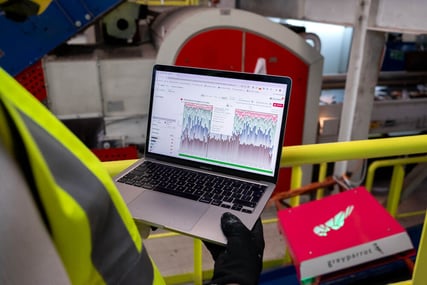According to the Waste and Resources Action Programme (WRAP), around 90% of people in the UK regularly recycle, but 80% still put one or more recyclable items into general waste (black bin) instead of the recycling bin. That amounts to 9 billion incorrectly-sorted objects which we could recover in a single year.
It’s one of the reasons the UK’s household recycling rate has plateaued in the last ten years, and the inspiration behind Recycle Week 2024’s “Rescue Me” theme — which educates consumers on commonly missed-recycled items.
To continue our own Recycle Week tradition of illuminating the theme with data, our analysts took part in the rescue effort. Over the last week, they combed through Greyparrot Analyzer data to find out just how many of the UK’s “most binned items” are actually reaching the average recovery facility.
Here’s what they looked for, and what they learned.

What's being binned, and what's being recycled?
Amongst the product categories on the recycling rescue agenda, yoghurt pots and cleaning product bottles were the most numerous:
- 7.4 billion yoghurt pots are discarded each year
- 845 million cleaning product bottles find their way into recycling sorting centres
When properly sorted, every one of them can be recycled and returned to the circular economy.
Our team took a deep dive into data from a major UK materials recovery facility to learn how many reach the recycling stage. Here’s what they found after reviewing Analyzer insights on 40,000 tonnes or 1.2 billion items of solid waste over a year period:
🧴 Over 8 million non-food grade plastic bottles
Non-food grade HDPE and PET bottles include some of WRAP’s high-profile targets for the Rescue Me campaign.
Cleaning bottles for bleach and detergent, health and beauty products and DIY products made up the non-food grade, coloured HDPE category, which represented:
- 4,648,012 total objects.
- This seems like a large quantity, but represents less than 1% of the facility’s total material.
Surface cleaning spray, washing-up liquid, and products like body wash, mouthwash, and vitamin bottles made up the non-food grade, clear PET category, amounting to:
- 3,440,794 total objects.
- This represents less than 0.5% of the facility’s total material.
Millions of these objects are already being recycled and returned to the circular economy every year, but there is still a massive amount of value to be recovered if more of us recycle them at home.

🍽 Over 49 million food grade PET and HDPE bottles
Compared to cleaning products, our Analyzer units saw far more food-grade plastic between 2023 and 2024.
That’s not surprising: recycling food packaging is already well-established in the UK. Many of us have our recycling bins in the kitchen, where it’s easy to sort packaging as soon as it’s used. Conversely, some mistakenly believe that detergents contain toxic chemicals that should not be in the recycling bin.
Milk and juice containers are natural HDPE items most commonly found by our Analyzer units, amounting to:
- 15,270,120 total objects.
- Over 2% of the facility’s total material.
Clear food grade PET was by far the most common plastic material, and included products like soft drink bottles and condiment containers:
- 34,524,817 total objects.
- Over 4% of the facility’s total material.

🥄 Less than 5 million white pots
Despite being at the top of WRAP’s rescue list, white pots (including those 7.4 billion yoghurt pots) weren’t spotted nearly as often as other food-grade objects.
Between 2023 and 2024, our Analyzer units only spotted:
- 4,881,062 total objects
- Or, less than 0.3% of the facility’s total material.

What we learned during our Recycle Week 2024 data dive
While it’s difficult to draw a comparison between food grade and non-food grade items in the waste stream, Analyzer insight into white pots suggests that WRAP are right: there’s a clear need for behaviour change when it comes to recycling certain materials. Millions of food grade items are being recovered, but too many white pots continue to reach the wrong bins.
Recycle Week is a campaign aimed at consumers, and the kind of data we gather in facilities across the UK and wider world can help them identify materials that need rescuing. Last year, WRAP’s Claire Shrewsbury has said that “data will help us maximise our efforts in the right places.”
Importantly, though, visibility into post-consumption waste can also ensure some of those materials are never used in the first place — or are designed to be as easy as possible for consumers to sort at home. That's why we developed the world's first waste intelligence platform for brands and packaging producers, and continue to expand our Greyparrot Analyzer's global footprint.
Learn how Greyparrot Analyzer gathers the kinds of insights we shared for this year’s Recycle Week here.




.png?width=501&height=285&name=IMG_6004%20(1).png)